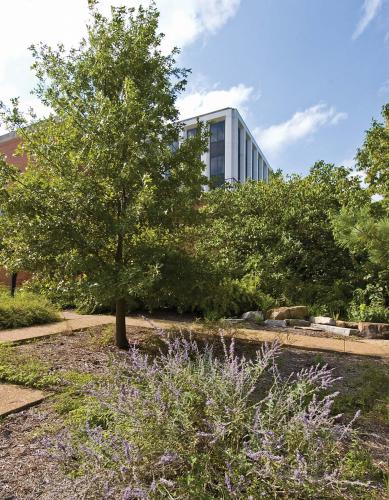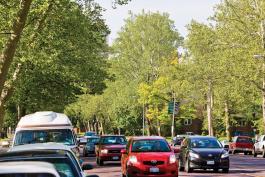Missourians love nature. We love our forests, fish, and wildlife for both common and personal reasons. Whether out in the woods or in the heart of our cities, we desire that connection. So we value city parks, greenway trails, tree-lined city streets and our backyard retreats — but these resources do more than just improve the view, especially in regard to our urban trees.
Trees in the city provide extensive and measurable social, environmental, and economic benefits. Unfortunately, not everyone is aware of these services. In order to better serve our citizens, and share the importance of our urban trees, we sent out an opinion survey.
The Department of Conservation’s Resource Science and Forestry divisions teamed up to develop the survey and learn how to better serve Missourians. Our goal was to determine citizens’ most pressing issues, gauge support for two hypothetical ballot issues, and find out how much citizens knew about tree programs in their communities. We also asked city leaders about their local agencies charged with managing urban trees, their budgets and personnel levels, and to determine which urban forestry issues were priorities. The responses to these questions revealed encouraging trends for our future.
Don’t Hold Back
Surveys were distributed in 2004 and 2012 to assess the opinions of citizens and city leaders. While the surveys were short, less than 20 questions, we learned a lot about how people felt about trees and how far they would go to have and care for trees in their yards or on city streets. This information is valuable to urban forest managers, city planners, political leaders, road and storm-water engineers, and other professionals working in our communities. Two cycles of surveys, each statistically representing all Missouri communities and residents, provided solid insight on opinions and trends.
Key trends for residents and public officials show communities are getting more trained staff to manage their trees, that residents are willing to pay taxes for city managed trees, that trees should be protected during urban development, and that fewer people think tree topping is a healthy practice for trees. Most importantly, Missourians think trees are part of a city’s infrastructure and just as important as streets and utilities.
The resident survey results show high importance for trees along streets and parks, for cleaning of our water and air, planting and care of new trees, and pruning for tree safety. Across all city sizes, 53 percent of Missourians said they would pay some level of tax, with 23 percent undecided. All city sizes of more than 50,000 residents were willing to pay a tax of $35 or more per year to manage trees for health and safety. Past results from the 2004 survey compared to 2012 show that people are becoming more aware of tree benefits to their homes and communities as well as the needs of planting, caring, and conserving this valuable resource.
The officials’ survey showed similar priorities with added concerns for funding and planning. Cities have been hiring or training more professionals, more than 25 percent have rules regarding tree preservation, and more than 50 percent say tree maintenance, planting, and hazard tree removal is important. Results also showed that more communities are making an effort to keep trees safe and employ professional guidance and rules to help guide their activities. In 10 years, the number of cities with care policies for public trees increased from 22 percent to 37 percent. Cities with tree protection policies went from 12 percent to 50 percent. These numbers show how important this issue has become to both residents and city leaders in our growing urban areas. City leaders are prioritizing urban forestry and keeping natural resources healthy.
Caring for Community Trees
Communities across the state have used urban forest programs to improve the livability and value of neighborhoods. Kansas City works hard to keep trees healthy for residents and visitors and is currently making a strong response to an emerald ash borer outbreak. St. Louis has a long history of managing trees with an extensive street and park system. Cities in every Department of Conservation region, including Springfield, Columbia, Liberty, Cape Girardeau, Hannibal, St. Joseph, Houston, and St. Peters, all manage trees at some level. Joplin has joined this group by hiring a city forester, having learned the benefits of trees after losing so many.
Demographics of respondents show more than 80 percent are homeowners and more than 60 percent are between 36 to 65 years old, educated, and have been raised inside some city limits. The survey shows that people feel a community should be responsible for its trees.
When our cities were first started, trees were everywhere. They were planted for the shade, food, and fuel they provided. Some of the benefits of trees to homeowners were replaced by insulation, technology, and supermarkets. Trees then seemed optional and not as important. However, for us to live as cost effectively as possible, its in our best interest to use both new technology and nature to provide the highest possible return on our investments. Consider your town’s streets and parks. Trees shade and add value to your home, they improve the neighborhood, and they clean water, soil, and air. They are an excellent investment for individuals and communities alike. City residents are a key factor in keeping trees a priority. Show your support by caring for your own trees, being active in your community, and telling city officials and other leaders that you support maintaining this valuable resource.






And More...
This Issue's Staff
Managing Editor - Nichole LeClair Terrill
Art Director - Cliff White
Staff Writer/Editor - Brett Dufur
Staff Writer - Jim Low
Photographer - Noppadol Paothong
Photographer - David Stonner
Designer - Stephanie Thurber
Circulation - Laura Scheuler






















